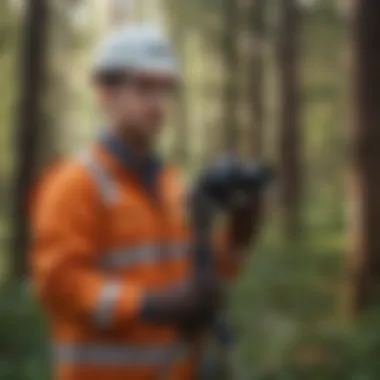Surveyor Jobs in the USA: An In-Depth Exploration


Intro
Surveyor jobs in the USA encompass a range of roles that play a crucial part in construction, land management, and urban planning. These positions require a blend of technical expertise, practical experience, and a solid educational background. As infrastructure continues to evolve, the demand for skilled surveyors grows, presenting a wealth of opportunities for those entering the field.
This exploration focuses on the nuances of various surveying roles available in the United States. It highlights educational pathways, certification processes, and skills essential for success in these roles. Additionally, it examines the impact of technological advancements on surveying practices and current industry trends.
By dissecting these elements, this article aims to equip aspiring surveyors, industry professionals, and enthusiasts with the knowledge needed to understand and navigate the landscape of surveying careers. This information is vital for both new entrants and seasoned professionals looking to stay relevant in a fast-evolving field.
Understanding the Role of a Surveyor
Surveyors play a crucial role in various industries, including construction, engineering, and land development. Their work involves measuring land, preparing sites, and ensuring compliance with applicable regulations. This section will elaborate on the responsibilities and types of surveyors, providing a comprehensive understanding of this profession. Understanding the role of a surveyor is vital because it underlies the foundation of many projects that shape our environment.
Definition and Core Responsibilities
A surveyor is a professional who gathers, analyzes, and interprets data related to land, buildings, and other constructions. Key responsibilities typically include:
- Measuring distances, angles, and elevations using specialized equipment such as theodolites and GPS systems.
- Preparing and maintaining maps, records, and reports for land use and development.
- Collaborating with architects, engineers, and government agencies to interpret survey data and ensure compliance.
- Providing boundary and property line information to landowners and potential buyers.
The effectiveness of a project often hinges on the precision of a surveyor’s work. Therefore, their ability to communicate findings clearly and effectively is just as important as their technical skills.
Types of Surveyors
Surveying is not a one-size-fits-all profession. There are various types of surveyors, each specializing in specific areas of the field. Below are some primary categories:
Land Surveyors
Land surveyors focus on the measurement and mapping of land boundaries, including the division of properties. They often work with residential, commercial, and industrial land development projects. A critical aspect of their work is establishing property lines, which is essential for preventing disputes between landowners. Their knowledge of local laws allows them to advise clients accurately, making them a reliable choice for real estate transactions. One unique feature is their proficiency in utilizing Geographic Information Systems (GIS) to analyze spatial data. However, land surveyors can face challenges such as fluctuating regulations affecting property laws.
Geodetic Surveyors
Geodetic surveyors deal with larger-scale surveying projects, considering the earth's curvature and its gravitational field. They play an important role in establishing control points that serve as reference markers for more localized surveys. Their expertise is essential in fields such as navigation, cartography, and even satellite positioning. The unique aspect of geodetic surveying lies in the sophisticated technology they employ, such as GPS satellites and aerial photography, providing high-accuracy data. However, the complexity of this work requires a higher level of specialized knowledge, which may limit the number of professionals in this area.
Marine Surveyors
Marine surveyors specialize in surveying bodies of water and the structures associated with them, like ports and docks. Their work is vital for shipping and navigation, addressing safety and regulatory compliance in nautical environments. The marine surveying field is often seen as exciting due to its dynamic work environments, ranging from ships to docks. These surveyors must navigate unique challenges, including harsh weather conditions and environmental regulations. One potential disadvantage is the often seasonal nature of their work, which can lead to income fluctuations.
Mining Surveyors
Mining surveyors focus on the extraction of resources such as minerals and ores. They ensure the mining operation is safe, efficient, and compliant with environmental regulations. Their contribution is particularly significant in assessing the viability of mining sites and mapping underground resources. Mining surveyors typically work in rugged terrains, utilizing advanced techniques like aerial mapping and 3D modeling to analyze mines. This field has become increasingly relevant as the demand for natural resources continues to rise. However, potential drawbacks include the hazardous environments they must sometimes work in, which requires strict adherence to safety protocols.
In sum, the different types of surveyors have unique responsibilities and challenges. Their expertise is essential in facilitating informed decision-making in various industries. Whether in land development, maritime activities, or resource extraction, surveyors are pivotal in shaping the physical landscape.
Educational Pathways to Becoming a Surveyor
The journey to becoming a surveyor is shaped significantly by educational pathways. Understanding the routes available helps aspiring surveyors make informed choices. Education not only provides essential knowledge but also equips individuals with technical skills vital for success in the industry. Comprehending these pathways highlights key elements that contribute to career prospects in surveying.
Degree Requirements
Associate Degree
An Associate Degree in surveying or a related field is often seen as an entry-level qualification. This degree usually takes around two years to complete and provides the foundational skills required for surveying tasks.
One key characteristic of the Associate Degree is its accessibility and focus on practical skills. Many community colleges offer programs that cover essential subjects such as land measurement and mapping technologies. This option is popular for those who prefer a quicker route into the workforce.
The unique feature of an Associate Degree is its ability to prepare students for entry-level positions, satisfying immediate workforce needs. However, it may limit advancement opportunities in some cases, as higher qualifications are often preferred for more senior roles.
Bachelor's Degree
Acquiring a Bachelor's Degree in surveying or geomatics is a more traditional route to becoming a surveyor. This degree typically requires four years of study and covers a wide array of topics including advanced surveying methods, technology, and legal aspects of land measurement.


The Bachelor’s Degree is considered a beneficial choice as it opens up more job opportunities and tends to lead to higher earning potential. Its breadth of knowledge prepares graduates for a variety of roles within the field.
A unique aspect of a Bachelor’s Degree is that it often includes internships, granting students practical experience. However, the time commitment and financial investment can be substantial, and not everyone has the resources for this path.
Graduate Programs
Graduate programs in surveying are typically pursued by individuals looking to specialize further. These programs often involve advanced study in specific areas like geodesy, land use planning, or hydrology.
One key characteristic of graduate programs is their focus on research and advanced technical skills. They are especially beneficial for those aspiring to take on leadership roles or academic positions.
The unique feature of graduate education is the opportunity to conduct significant research projects, which can enhance a candidate’s expertise. However, this pathway may require considerable time and effort, which could be a deterrent for some.
Continuing Education and Training
Certification and Licensing for Surveyors
Certification and licensing are crucial components in the profession of surveying. They ensure that practitioners meet the essential standards needed for accuracy and professionalism. Given the technical nature of surveying, having a proper certification can command respect and trust from clients and employers alike. Without requisite certification, surveyors may find it difficult to operate legally or gain employment in various sectors. This article will break down the national and state-specific standards necessary for surveyors in the United States.
National Licensing Standards
In the U.S., the national standards for surveying licensing are primarily governed by the National Council of Examiners for Engineering and Surveying (NCEES). They provide a framework that different states can adopt in whole or part. The key elements in this national standard include:
- Fundamentals of Surveying Exam: Most states require surveyors to pass this exam as the first step. It assesses foundational knowledge.
- Principles and Practice of Surveying Exam: This is often taken after gaining work experience. It evaluates advanced surveying knowledge.
- Registration Requirements: Many states require surveyors to register with the NCEES, which processes exam results and provides licensing.
Obtaining these licenses is not a trivial task. It often requires years of education and experience. Thus, prospective surveyors must consider this commitment when planning their careers.
State-Specific Requirements
While national standards provide a general outline, state-specific requirements can differ considerably. Each state in the U.S. has its own board of professional licensing, which dictates the criteria for licensure. Here are several components that often vary:
- Education: Some states may demand a specific type of degree from an accredited program, while others may allow for equivalent work experience.
- Experience: The number of years of supervised experience required can vary from state to state. This can range anywhere from two to four years.
- Additional Exams: Certain states may require additional state-specific examinations focusing on local laws and geography.
It’s important for aspiring surveyors to check the requirements in their respective states. Understanding these unique regulations can save time and additional effort when pursuing a career in surveying.
Certification and licensing serve as vital components in establishing credibility in the surveying profession.
Surveying is a field where precision matters, and having the right certifications ensures that professionals are equipped to handle the complexities they will face in their work. The importance of keeping abreast of changes in regulations cannot be overlooked. As laws and technologies evolve, so too must the certifications and licensures of surveying professionals.
Essential Skills Required for Surveyors
Understanding the essential skills required for surveyors is crucial in determining their effectiveness in performing various tasks. These skills not only enhance their competency in fieldwork but also facilitate successful collaboration with clients and stakeholders. Surveyors operate in a technical world that demands precision and insightful analysis, making these skills integral to their professional development. The ability to adapt and continuously develop these skills can also lead to better job performance and career advancement.
Technical Proficiency
Technical proficiency is fundamental for surveyors. They must have a strong grasp of various tools and technologies used in surveying, including total stations, GPS equipment, and geographic information systems (GIS). Familiarity with computer-aided design (CAD) software is essential, as much of the data collected requires precise interpretation and representation. Being well-versed in these technologies ensures that surveyors can efficiently collect data, analyze it, and produce accurate and reliable reports.
Moreover, a surveyor's technical skills also extend to understanding regulatory requirements. Knowledge regarding local, state, and federal guidelines ensures that their work is compliant. This aspect of technical proficiency also enhances their ability to make informed decisions that drive projects efficiently.
Analytical Skills
Analytical skills are crucial for processing and interpreting the vast amounts of data that surveyors gather. With a range of measurements in plain sight, the ability to critically evaluate data is paramount. For instance, surveyors must analyze topographical maps, discern patterns in the data, and forecast potential challenges in projects. This analytical capability helps in problem-solving, such as identifying discrepancies in data collection or analyzing the physical constraints of the survey area.
Furthermore, the changing nature of environments—combined with technological advancements—means that surveyors need to stay sharp in applying innovative analytical methods. This adaptability allows them to tackle diverse projects more effectively, which is increasingly important in a competitive job market.
Communication and Collaboration
Effective communication and collaboration skills are often underestimated but are vital in the surveying profession. Surveyors work closely with engineers, architects, and clients, translating complex data into understandable terms. They must convey findings clearly in both spoken and written forms. Skillful communication fosters a smooth workflow, reduces misunderstandings, and builds trust among project teams.
Teamwork is also important during fieldwork. Surveyors often collaborate with other professionals, such as construction crews and environmental scientists. Incisive collaboration skills help ensure that every aspect of a project is integrated seamlessly, leading to successful outcomes. Regular briefings and feedback sessions can further enhance team dynamics, aligning all members toward common goals.
"Success in surveying projects often hinges on effective communication among all stakeholders. Regular updates and clear briefings can make a distinct difference in project execution."


In summary, being a successful surveyor requires a blend of technical proficiency, analytical skills, and communication capabilities. Each of these elements contributes to the efficiency and quality of surveying work. This synergy not only leads to personal growth for surveyors but also ensures successful project delivery, making them valuable assets in any setting.
Technological Innovations in Surveying
In the evolving field of surveying, technological innovations have become increasingly essential. These advancements not only streamline processes but also enhance accuracy and efficiency. The integration of new technologies reshapes traditional practices, opening avenues for safer and more precise ways of conducting surveys. Understanding these innovations is key for professionals in the industry. It provides insights into how they can leverage these tools to improve their work.
Use of Drones in Surveying
Drones have radically transformed surveying by allowing for aerial data collection. This technology provides high-resolution images and detailed topographical maps with less manual effort. Drones are capable of accessing hard-to-reach areas, making them an invaluable tool in challenging terrains. Using drones can significantly reduce the time needed to gather site data and enhance the quality of the information captured.
Software Tools for Surveyors
Software tools play a crucial role in modern surveying practices. Two primary types of software that surveyors utilize are CAD software and GIS applications. They facilitate analysis, visualization, and data management.
CAD Software
CAD (Computer-Aided Design) software is fundamental in the realm of surveying. It enables surveyors to create precise drawings and models. A key characteristic of CAD is its ability to improve design accuracy through detailed representations of terrain. This precision makes CAD software a popular choice in the surveying field.
One unique feature of CAD is its layering system, which allows users to overlay multiple data sets. This capacity for combining various elements in one view enhances decision-making in complex projects. However, the learning curve for CAD can be steep, especially for those unfamiliar with design software, which can pose challenges initially for some surveyors.
GIS Applications
GIS (Geographic Information System) applications are equally vital for surveyors. They allow for comprehensive spatial analysis and management. The key characteristic of GIS is its ability to integrate various datasets, which can provide insights into geographic trends and patterns. This makes GIS a beneficial tool for survey planners and developers.
A unique feature of GIS applications is the capacity to visualize data geographically, assisting surveyors in understanding relationships and geography better. The downside may be the need for substantial training to utilize GIS effectively, but the benefits in managing survey data greatly outweigh these challenges.
The Role of Automation
Automation is becoming a significant trend in surveying, altering how tasks are completed. By automating routine operations, surveyors can focus on more complex analytical tasks. This leads to improved productivity and innovation within the field. However, integrating automated systems also requires investment and understanding of new tools—factors that surveyors must carefully evaluate as they embrace these modern methods.
Trends in the Surveying Workforce
Understanding the trends within the surveying workforce is critical for both current professionals and those aspiring to enter the field. The surveying profession has undergone significant changes in recent years, influenced by technological advancements, economic shifts, and evolving workforce demographics. These trends provide insights not only into current employment conditions but also into future opportunities and challenges facing surveyors in the United States.
Current Job Market Overview
The current job market for surveyors is influenced by various factors including construction projects, infrastructure development, and real estate activities. As urban areas expand and require detailed mapping and planning, the demand for skilled surveyors has increased. Despite some fluctuations related to economic conditions, there is a notable stability in the demand for surveyors in various sectors such as construction and civil engineering. This is particularly true in regions with booming real estate markets.
Furthermore, surveyors are increasingly being integrated into multidisciplinary teams that include architects and engineers, broadening their role beyond traditional surveying functions. The emphasis on collaborative projects often results in more job openings and can enhance career prospects for professionals in the field.
Impact of Economic Factors
Economic factors bear a weighty influence on employment trends in surveying. For example, fluctuations in housing markets can directly affect the number of active construction projects, which in turn impacts the need for surveyors. During economic downturns, companies might restrain hiring, leading to tighter job markets. Conversely, in periods of economic growth, companies heavily invest in infrastructure and development projects, significantly boosting job opportunities.
Additionally, government budgets play a crucial role. Increased funding for public infrastructure can lead to a surge in job openings for surveyors employed by state and local government agencies. In this respect, surveyors often find themselves reliant on the health of the economy and the decisions made at governmental levels.
Diversity and Inclusion in Surveying
Diversity and inclusion are rising priorities within the surveying field. The industry recognizes long-standing disparities in gender and racial representation. Many organizations are actively pursuing initiatives to attract a more diverse workforce. These efforts are vital, as a variety of perspectives can enhance problem-solving and innovation within the profession.
Encouraging diversity also has implications for the overall public perception of surveying as a career choice. By promoting inclusivity, the industry can appeal to a broader audience, ensuring it gains interest from underrepresented groups. This can contribute not only to improving workforce demographics but also to enriching the profession with a wider range of ideas and experiences.
"The future of surveying depends on embracing a diverse workforce that reflects the communities we serve."
In summary, the trends in the surveying workforce highlight crucial elements such as job market dynamics, economic influences, and the push for increased diversity. These aspects are interconnected and can significantly influence both individual career paths and the future landscape of surveying as a profession.
Career Opportunities in Surveying
The field of surveying presents a variety of career opportunities that cater to different interests and skill sets. Understanding these options is essential for those considering a career as a surveyor. The benefits of a career in surveying are notable; there is substantial demand for skilled professionals in this area. This demand is rooted in ongoing projects in urban planning, infrastructure development, and environmental management. The surveying profession also offers pathways for specialization, which can lead to increased job satisfaction and professional growth.
Employment Sectors for Surveyors


Surveyors can find employment across various sectors, each with its distinct characteristics and advantages.
Public Sector
The public sector offers substantial career opportunities for surveyors. Roles often exist within government agencies, local municipalities, and land management organizations. One key characteristic of the public sector is job stability; government positions typically provide consistent employment, benefits, and pensions.
This sector is particularly beneficial for those who desire to work on public infrastructure projects, such as highways, bridges, and public buildings. One unique feature of public sector employment is the potential for surveyors to impact community development positively. However, there can be limitations on project budgets and slower decision-making processes, which may be a disadvantage for some individuals looking for a fast-paced work environment.
Private Sector
In contrast, the private sector is often seen as a more dynamic employment option. Surveyors in this sector work with private firms, engineering companies, or construction businesses. A key advantage of the private sector is the potential for higher salaries and bonuses compared to government roles. Work in this area can be project-based, leading to varied experiences and the chance to tackle a diverse set of problems.
The private sector is also characterized by its competitive nature, which can drive innovation and professional development. However, the pressure to meet deadlines and client demands might be demanding. Therefore, surveyors must manage their workload efficiently.
Non-Profit Organizations
Non-profit organizations represent another employment avenue for surveyors. These positions may involve environmental conservation, community development, or research projects. A significant aspect of working in non-profit organizations is the opportunity to align one's career with personal values. Surveyors can contribute to meaningful projects that aim to improve society and the environment.
One unique feature of non-profit work is the collaborative atmosphere, often fostering teamwork among professionals across multiple disciplines. Nevertheless, positions in this sector might offer limited financial compensation and less job security compared to public or private sectors.
Advancement Opportunities
Advancement within the surveying field can vary depending on the sector but typically offers several pathways. Surveyors may ascend to supervisory roles, become project managers, or even start their own consultancy firms. Many employers encourage continued education and professional development, allowing surveyors to stay current with technology and regulations.
Certifications can further enhance prospects, as specialized knowledge can lead to senior positions. As the industry evolves, those who adapt and seek out new challenges will find numerous opportunities to advance their careers.
Challenges Facing Surveyors Today
Surveyors play a crucial role in the development and management of land and resources. However, they face numerous challenges that can impact their work. Understanding these challenges is essential for anyone considering a career in surveying or involved in the field. Addressing these issues not only helps professionals adapt but also promotes better practices in surveying. Two primary challenges include changing regulations and environmental concerns, both of which require heightened awareness and proactive responses from surveyors.
Changing Regulations and Standards
Regulations governing surveying practices are dynamic and can shift based on legal, environmental, and technological trends. Surveyors must stay informed of any alterations to state and federal laws that affect their work. For example, licensing requirements can change, influencing how surveyors maintain their credentials. Regulations often aim to enhance public safety and environmental management.
To cope with these changes, it is necessary for surveyors to engage in continuous education. Workshops, seminars, and certification courses can help surveyors remain compliant and knowledgeable about current practices. Moreover, professional organizations offer updates and resources to guide surveyors through new standards.
Therefore, adaptability becomes a central skill in ensuring that surveyors can navigate the complexities of ever-evolving frameworks. Regular training can empower professionals and fortify their ability to deliver accurate and compliant surveying services.
Environmental Concerns
Environmental issues present a significant challenge for surveyors today. As society becomes increasingly aware of climate change and its impacts, surveyors must act responsibly. This means they need to consider the environmental effects of their projects and make sustainable decisions during land development.
For instance, surveyors often conduct assessments to identify potential environmental impacts before any land use changes. This includes evaluating the consequences of urban development on local ecosystems, water resources, and wildlife habitats. Increased regulations often demand thorough environmental assessments, an area where surveyors must be well-trained.
Surveyors might also face challenges related to natural disasters, such as flooding or hurricanes, especially in vulnerable regions. They need to employ innovative techniques and technology to minimize risks associated with these events. Many surveyors are now integrating Geographic Information Systems (GIS) into their assessments to better predict and mitigate environmental risks.
"The future of surveying lies at the intersection of technology and environmental stewardship."
Future Outlook for Surveying Careers
The future of surveying careers is a topic of significant importance, particularly in the context of rapid technological advancements and evolving industry needs. As the landscape of construction, land development, and environmental planning transforms, surveyors must adapt to new challenges and opportunities. This analysis sheds light on emerging trends and potential growth areas in surveying, underlining their impact on future employment prospects.
Emerging Fields of Surveying
The surveying profession is diversifying, with emerging fields that offer new avenues for career development. One notable area is Geographic Information Systems (GIS), where professionals utilize spatial data to analyze and improve planning and decision-making processes. The integration of GIS into various industries, including urban development, agriculture, and environmental management, enhances the demand for skilled surveyors.
Another promising domain is the use of drones in surveying. Drone technology provides surveyors with efficient data collection methods that are less labor-intensive and more precise. This advancement generates significant interest among companies seeking quick turnaround times for projects. Additionally, areas like land reclamation and renewable energy projects, such as wind farm installations, are also gaining traction, further broadening the scope of work for surveyors.
As surveyors embrace new technologies, they are ideally positioned to take advantage of the information age's transformative potential.
Long-Term Job Stability
The surveying profession enjoys a degree of long-term job stability, primarily due to its foundational role in various sectors. Whether it’s in construction, civil engineering, or environmental conservation, surveyors are integral to the accurate execution of projects. Additionally, the increasing complexity of infrastructure requirements, especially in urban areas, ensures a steady demand for qualified surveyors.
One significant factor contributing to this stability is the aging workforce in surveying. Many experienced professionals are nearing retirement age, leading to a gap that younger surveyors can fill. Consequently, there are opportunities not only for new entrants into the field but also for those seeking advancement into leadership roles.
Furthermore, the rise of remote work capabilities and digital collaboration tools provides surveyors with flexibility in their work environments. This versatility not only aids in job satisfaction but also encourages talent retention within the profession.







